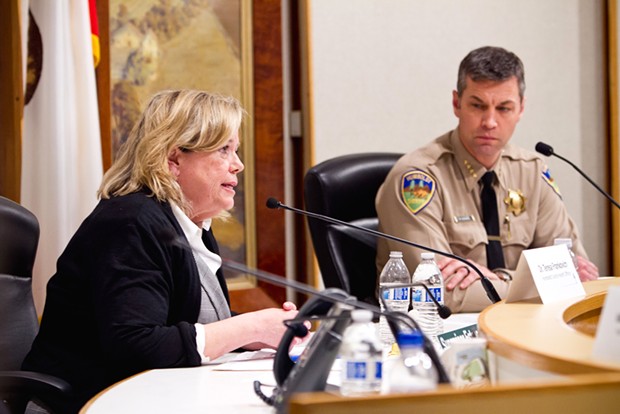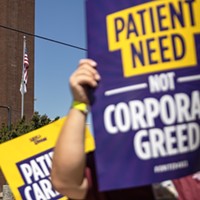Upward Trajectory
As Humboldt's numbers spike, officials take stronger action
By North Coast Journal Staff[
{
"name": "Top Stories Video Pair",
"insertPoint": "7",
"component": "17087298",
"parentWrapperClass": "fdn-ads-inline-content-block",
"requiredCountToDisplay": "1"
}
]
In a flurry of activity over the late afternoon and evening hours of March 30, Humboldt County officials announced that the local spread of COVID-19 was growing more serious, with two community transmission cases, and took more drastic actions to contain the virus.
Humboldt County Sheriff William Honsal declared a local emergency, putting his Office of Emergency Services in charge of directing a countywide, multi-agency response to the pandemic and paving the way for state and federal disaster reimbursements. Public Health Officer Teresa Frankovich, meanwhile, announced that she was broadening the shelter-in-place order she'd instituted 10 days earlier — a time span that saw the county's case count spike from two to 21. The day after Frankovich's announcement, the case tally jumped again to 27.
Here's a brief rundown of the latest developments as the Journal went to press March 31.
The Curve
Perhaps the biggest news to hit Humboldt County was word that public health investigators had been unable to find evidence that two patients had been in contact with any other people confirmed to have the virus or that they had traveled outside the local area, leading investigators to believe they contracted the disease from an unknown source within the community.
"We must all acknowledge the fact that while case counts are incredibly important for monitoring this pandemic, everyone must assume that COVID is circulating within their own city or town, and act accordingly," Frankovich said. "The measures we have been advocating remain critically important: staying at home unless you must go out for an essential need; staying at home when you're ill until you have been without fever for three days without use of [fever reducing medicine], have had improvement in your symptoms and have had at least seven days since the onset of your symptoms; wash your hands frequently and well; use hand sanitizer when that isn't available; cover your coughs and sneezes; clean commonly used surfaces."
The county's caseload has risen sharply since March 20, when it announced its second positive case in someone who had recently returned from traveling in a "high-risk" country. (The first positive test was announced Feb. 20 in someone who'd just returned from China and has since recovered.)
On March 24, the county announced three additional cases, including positive tests from two members of a group that had recently returned from international travel. The following day, it announced five additional cases, all related to the same traveling group. Two more tests came March 26, followed by two more March 27, four on March 28, three on March 30 and six on March 31.
The Humboldt County Public Health Laboratory, which can turn around tests in less than 48 hours, twice as fast as corporate labs used by local healthcare providers, reported March 31 having a capacity on hand to conduct another 750 tests. Frankovich said Public Health is working diligently through all channels to get additional testing supplies, which could allow for more widespread testing. But in the meantime, she said the department continues to prioritize those who are gravely ill, both symptomatic and especially vulnerable due to underlying health conditions or at risk of spreading the virus widely, like healthcare workers or those in skilled nursing facilities. Mildly symptomatic people, she said, should self-quarantine and monitor their symptoms, contacting a healthcare provider or Public Health if they grow worse.
Local Emergency
Honsal explained that the declaration of a local emergency is not just a response to spiking case numbers but to overall conditions in the county, including the devastating impact the pandemic is having on the local economy, and an effort to leverage aid from state and federal agencies.
"[T]he imminent threat posed by aforesaid conditions warrant and necessitate the proclamation of a local emergency to enable the County of Humboldt and other local government entities to adequately plan, prepare and preposition resources to be able to effectively respond to the threat posed by COVID-19 and to warn Humboldt County residents and visitors of the threat posed by COVID-19 and enable them sufficient time to plan and prepare," he said in a release.
The local emergency declaration is for seven days but can be extended by the board of supervisors. Honsal's announcement came a little less than three weeks after Frankovich declared a public health emergency and 11 days since the shelter-in-place order for the county, which will now be in effect indefinitely.
Modified Order
The new shelter-in-place order Frankovich issued March 30 includes another wave of closures and restrictions, including limits on hotel rooms and short-term rentals, as well as golf course closures and a ban on playing team sports in any setting. The initial order allowed essential businesses — including healthcare providers, gas stations and stores that sell groceries, pet food, hardware and medications — to remain open, but shuttered anything deemed a non-essential operation. (It does allow business to operate if employees are telecommuting from home.)
Residents were bluntly told to stay home for all but essential needs such as running to the store or exercising while practicing social distancing practices, meaning to stay 6-feet away from others. The new order imposes additional restrictions, prohibiting hiking on trails that don't allow for 6 feet of separation or other outdoor activities that put people within the recommended spacing. And no more self-serve options at any establishment providing food, such as salad bars or bakery goods, that can't be washed by the consumer before consuming. (The order does still allow restaurants to operate for take-out or drive-through customers.)
The order also bans hotels, motels, campgrounds, vacation rentals and other temporary residences from renting to non-county residents except under certain circumstances, including travel for essential services.
Most of the other requirements remain the same as an earlier order, such as a ban on public or private gatherings and the allowance of essential business to remain open.
To date, Honsal and local police chiefs have said they will take an educational approach to enforcing the order and the county set up a COVID compliance tip line (441-3022) where residents can report individuals or businesses they believe to be in violation. But the sheriff has also maintained he's also willing to wield a heavier hand should he feel people or entities are in willful violation.
Economic Fallout
The economic impact of the COVID-19 shelter-in-place order has been swift and severe. By March 27, the latest date for which data was available before the Journal went to press, the county had seen 1,014 jobs lost from 335 businesses, which reported a combined loss of $4.4 million in revenue, according to survey results released by the county's Emergency Operations Center.
The mass layoffs have had reverberating effects as the state Employment Development Department announced that for the week ending March 21, it had received more than 186,000 new unemployment claims. For context, that's more than 70,000 more claims than the prior weekly record, which came in the height of the Great Recession.
The economic uncertainty caused several local cities to pass moratoriums on evictions, and Honsal announced his office will not enforce eviction orders for the time being.
Meanwhile, businesses and individuals are scrambling to figure out how to access a rash of potential assistance funds, including a $1 billion bill passed by the state Legislature to be spent by Gov. Gavin Newsom as he sees fit to prevent COVID-19 spread and aid recovery, and a $2 trillion federal stimulus bill that is reported to include increased unemployment benefits and one-time payouts to individuals.
The Push for PPE
But as much as Humboldt County has seen a spike in positive test results and taken some dramatic steps aimed at reducing the virus' spread, Honsal stressed March 30 that we are in the "calm before the storm."
Local officials are scrambling to make sure healthcare providers, social workers and an array of first responders have the personal protection equipment necessary to protect them from potentially deadly exposure to the virus.
Last week, the Humboldt County Office of Emergency Services distributed 30,000 pieces of the protective equipment, known as PPE, to 27 local agencies, including healthcare facilities and first responders. But the press continues, as nobody knows exactly what they will need when Humboldt County's infection rates reach their peak and running out of the masks, gloves, protective eyewear and sanitation equipment could have disastrous consequences on healthcare workers and the local system's ability to operate at maximum capacity and weather the storm.
"PPE is an issue, especially if the supply chain doesn't respond better in the very near future," Open Door Community Health Centers CEO Tory Star wrote in an email to the Journal, adding his organization is in "daily contact" with local, state and federal authorities on the topic. "The situation is still deeply concerning to us, as if we don't have the proper supplies, we will have to curtail services in order to protect our staff."
Throughout Humboldt County, agencies from hospitals to police departments are working to both stockpile and ration supplies in a careful dance to prepare for the unknown.
Star said Open Door, which operates a dozen community health centers across the North Coast, has centralized its PPE inventory management system to better keep tabs on supply levels. Open Door has also concentrated clinical services — pushing a majority of appointments to telephone or video visits — partly in an effort to limit the consumption of supplies.
The items most in-demand locally, as well as across the state and nation, are N95 masks, respiratory protective devices that are designed to fit very closely to the face and filter out airborne particles. According to the food and drug administration, when properly fitted, they block at least 95 percent of very small test particles. This, coupled with the fact that studies have found the degree of exposure to COVID-19 to be a factor in the severity of illness, is why they are in such acute demand. But officials are also scrambling to secure stockpiles of surgical masks — looser-fitting, disposable cloth masks — as well as rubber gloves and sterilization supplies.
Mad River Community Hospital has instituted a tight management system for PPE, limiting them to essential uses, according to Disaster Preparedness Coordinator Jacqueline Martin. She said the hospital is also looking to set up a telehealth system and reschedule appointments to save its supply, especially of the N95 masks.
But the hospital, with the help of community generosity, has also gotten creative to meet the uncertain need. Unable to restock the headbands necessary to hold protective face shields in place, it enlisted the help of some local 3D printers, who rose to the challenge and helped replenish the hospital's supply in a matter of days. Similarly, a licensed clinical social worker started a local Facebook group coordinating an effort to make homemade PPE masks. While they aren't nearly as effective as the N95 masks, Mad River said in a press release that it has been able to use the homemade masks to "extend the life" of its N95 supply.
St. Joseph Health System spokesperson Christian Hill said both St. Joseph and Redwood Memorial hospitals received added supplies of N95 masks, face shields and goggles last week. Additionally, he said the entirety of the St. Joseph Health System — which now operates in seven states — is working to balance supplies and shift products to areas of greatest need, and to ensure all facilities have what they need when they need it.
"We know that in order to care for our patients, we must ensure the health and safety of providers and all of our caregivers," he said, adding that St. Joseph is working directly with manufacturers, as well as all levels of government, to build up PPE supplies.
But it's not just healthcare providers in need of PPE. At the virtual town hall, officials said EMTs, firefighters, police officers and social workers will all need to be outfitted in order to safely navigate the encounters that surely loom in the near future.
"I don't think we're prepared enough so we'll be making more requests," Honsal said.
Frankovich jumped in.
"Obviously, we want to be in a position where the moment that we are short we are not asking," she said.
Journal staffers Iridian Casarez, Kimberly Wear and Thadeus Greenson contributed to this report.
Speaking of...
more from the author
-
David Lee Sams: 1931-2024
- Mar 31, 2024
-
Carol J. Lauer: 1930-2024
- Mar 30, 2024
-
Ione Franz: 1936-2024
- Mar 30, 2024
- More »
Latest in News
Readers also liked…
-
Through Mark Larson's Lens
A local photographer's favorite images of 2022 in Humboldt
- Jan 5, 2023
-
'To Celebrate Our Sovereignty'
Yurok Tribe to host gathering honoring 'ultimate river warrior' on the anniversary of the U.S. Supreme Court ruling that changed everything
- Jun 8, 2023



































